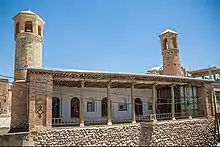| Tarikhaneh Mosque | |
|---|---|
مسجد تاریخانه | |
 | |
| General information | |
| Type | Mosque |
| Architectural style | َEarly Islamic |
| Location | Damghan, Semnan Province, Iran |
| Address | Mutahari St., Damghan |
| Coordinates | 36°9′51″N 54°21′15″E / 36.16417°N 54.35417°E |
| Owner | Government of Iran |
The Tarikhaneh Mosque (Persian: مسجد تاریخانه; also variously rendered as Tarikhana Mosque or Tarikh Khana Mosque), is a historic monument located on the southern limit of the present day city of Damghan, Iran.
Etymology
"Tarikhaneh" is derived from tari ("god") and khaneh ("home"), thus meaning "god's home".[1]
History
The chronology of the building's construction is not well-documented.[2] Based on its very close similarities with earlier Sassanian architecture, it is likely from the first centuries of Islamic rule, possibly in the 8th century.[3][4][5] Some scholars have suggested that is overall form and style corresponds more to the 9th century.[2]
Architecture
The main plan consists of a square courtyard which is surrounded by arcades of barrel vaults supported by slightly pointed fired brick arches set on thick circular pillars, typical of Sassanid architecture.[6] The pillars are 3.5 meters tall and almost 2 meters in diameter.[7] The hypostyle prayer hall consists of several naves or aisles divided by arcades and covered by vaults, with the central nave being larger than the others.[8]
Standing together at a distance from the mosque are the remains of a square column of uncertain date, possibly part of the original construction period and a cylindrical minaret.[9] The latter was built sometime in the years 1026 to 1028.[9][8][10] It resembles the style of later Seljuk minarets.[8] The minaret is 4.2 meters in diameter; its top has fallen, but originally it must have measured more the 30 meters high, with a gallery supported on muqarnas corbels.[9] The tower is strikingly divided into six zones of ornamentation, each rendered in brick with a different geometric pattern. An inscription at around mid-way up the tower records that its construction was commissioned by the local governor, Abu Harb Bakhtyar ibn Muhammad.[9]
 View from the courtyard to the prayer hall
View from the courtyard to the prayer hall Columns and arches of the prayer hall
Columns and arches of the prayer hall Vault over the central nave of the prayer hall
Vault over the central nave of the prayer hall The minaret
The minaret
References
- ↑ Damghan Tarikhane Mosque. Tarikhaneh: Miras Semnan.
- 1 2 Blair, Sheila; Bloom, Jonathan M. (2011). "Iraq, Iran, and Egypt: the Abbasids". In Hattstein, Markus; Delius, Peter (eds.). Islam: Art and Architecture. h.f.ullmann. p. 110. ISBN 9783848003808.
- ↑ M. Bloom, Jonathan; S. Blair, Sheila, eds. (2009). "Architecture; IV. c. 750–c. 900". The Grove Encyclopedia of Islamic Art and Architecture. Vol. 1. Oxford University Press. p. 82. ISBN 9780195309911.
- ↑ Kuban, Doğan (1974). The Mosque and Its Early Development. Brill. p. 22. ISBN 978-90-04-03813-4.
- ↑ Adle, Chahryar (2011) [1993]. "DĀMḠĀN". Encyclopaedia Iranica (Online). Retrieved 2023-08-03.
- ↑ Goode, Patrick (2009). The Oxford Companion to Architecture. Oxford University Press. p. 467. ISBN 978-0-19-860568-3.
- ↑ Ernst J. Grube; James Dickie; Oleg Grabar; Eleanor Sims; Ronald Lewcock; Dalu Jones; Gut T. Petherbridge (1978). George Michell (ed.). Architecture of the Islamic World. Thames and Hudson. ISBN 0-500-27847-4.
- 1 2 3 O'Kane, Bernard (1995). Studies in Persian Art and Architecture. The American University in Cairo Press. pp. 207–210. ISBN 978-977-424-370-7.
- 1 2 3 4 Blair, Sheila (1991). The monumental inscriptions from early Islamic Iran and Transoxiana. Brill Academic Publishers. p. 96. ISBN 978-90-04-09367-6.
- ↑ Hattstein, Markus; Delius, Peter, eds. (2011). Islam: Art and Architecture. h.f.ullmann. p. 110. ISBN 9783848003808.
External links
![]() Media related to Tarikhaneh at Wikimedia Commons
Media related to Tarikhaneh at Wikimedia Commons









%252C_2014.JPG.webp)





